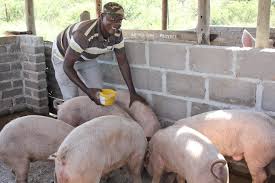Pig farming otherwise known as a piggery project is one of the lucrative aspects of agricultural animal husbandry. Pig farming can yield the farmer so much money if properly handled and managed professionally.
Today, let us discuss about the 7 things you need to consider when starting up a piggery project (piggery farm) and they include but not limited to the following:
1. Capital
The amount of money required to set
up the piggery project is dependent on the unit size one intends to
operate. In pig production capital is needed to construct the sties
and to buy equipment and breeding stock.
Working capital is also needed to pay for feed, drugs and labor for the first year of operation. For a breeding/feeding unit, cash outflow tends to increase to a maximum at the end of the first 11 months of operation while cash inflow starts only 11 months after commencement of the project.
It is therefore important for the farmer to have sufficient funds to sustain the operations of the piggery for a period of 11 months.
Read Also: Proper Ways of Feeding Pigs
2. Knowledge
Knowledge on how to successfully
manage a pig production enterprise is very important. In order for
the farmer to avoid making costly mistakes in the running of the pig
production enterprise he should be trained in pig husbandry.
3. Breeding Stock

The output of a unit can be limited by the quality of breeding stock. Inferior breeding stock results in an inefficient utilization of feed and space.
Farmers must be prepared to pay high prices for quality stock. Poor quality breeding stock may be cheaper in the short term but in the long run they will be expensive.
4. Market
Farmers have to identify the market for their pigs before they start producing them. Farmers should desist from the practice of hunting around for a market when their pigs are ready for sale. When the producer has identified a market he must ask himself whether the price being offered for his pigs will be enough to make the project viable.
Read Also: Best Piglets Management Practices
An important point to consider when
one is choosing a market is the distance to the market. If the
distance to the market is long the project will incur high transport
costs and hence will be less viable.
5. Water
Water should be of the right
quantity and quality. Inadequate water supply depresses the growth
rate of the pigs. Lactating sow need a lot of water for milk
production. The pigs’ water requirements will vary with the
weather.
On a very hot day the pig will use
more water than during a cold day. As a general guide a farmer should
budget about 150 litres of water per sow per day.
6. Housing

The pigsties should be constructed
in a way that will allow the stockman to carry out his daily duties
with ease. The sties have to be designed in a manner that will help
management in monitoring the pig enterprise.
Poor housing designs can lead to
disproportionate food sharing, inefficient utilization of space, feed
wastage and poor performance of the pigs among other things.
7. Feed Availability
A guaranteed supply of feed is a
prerequisite for the successful operation of a piggery project. Feed
account for about 80% of the production costs on a pig production
enterprise. Pig feeds are compounded using maize or other small
grains and concentrates.
The farmer should budget about 3.4 tonnes of maize per sow per year if he is to operate a breeding/feeding unit because pig production is a good business when properly and well managed.
Read Also: How Long Does It Take a Hazelnut Tree to Produce Nuts?
Frequently Asked Questions
We will update this section soon.

